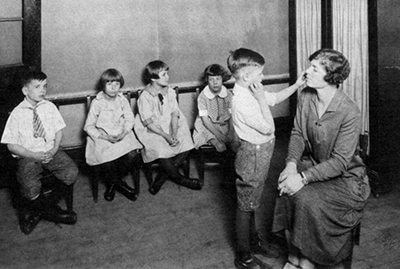Class News
Gerald Shea '64: An excerpt from his new book
The following excerpt from Gerry's new book, The Language of Light: A History of Silent Voices, was published by The Paris Review on August 16, 2017. Gerry's first book was Song Without Words: Discovering My Deafness Halfway Through Life (2013), a memoir about his partial deafness. You can order both books on our Publications page.
Teaching Them to Speak: On Juan Pablo Bonet and the History of Oralism

Beginning in the Middle Ages and continuing well beyond the eighteenth century, “medical” treatments were devised in an effort to “cure” deafness. Many were violent, yielding illness, suffering, and at times death: Hot coals were forced into the mouths of the deaf to get them to speak “by the force of the burning.” Catheters were inserted through the nostrils, twisting them through the nasal cavity and into the Eustachian tubes and injecting burning liquids. Wide holes were drilled into the crown of a young girl’s skull so she could “hear” through the openings. Severe blistering agents were applied to the neck, scorching it from nape to chin with a hot cylinder full of magical burning leaves. Adhesive cotton was applied and set afire; vomitories and purgative agents were used; hot needles were injected into the mastoids, or the mastoids were removed altogether. One French doctor threaded the necks of deaf students with seton needles and, with a hammer, fractured the skulls of a number of deaf children just behind the ear. All of these practices were based on the idea that drilling, cutting, fracturing, scorching, or poisoning would “open up” the ear, the brain, and the body to the world of sound.
Sixteenth-century Europe also saw a bloodless but equally ineffectual approach to treating the deaf, one concerned less with the intelligibility of speech and more with reproducing its sounds. The century marked the beginning of the oralist movement, which contended that the deaf should abjure their “signs” and learn to speak, a practice motivated in part by a central problem for aristocratic families in Europe with deaf children: they had to be able to speak in order to inherit. And so the influence of those who taught the deaf grew. One of the most well known among those teachers was Juan Pablo Bonet, a Spaniard. Bonet and those who followed him were either charlatans or incompetents; they mistook their students’ inability to speak for ignorance, and they not only failed to acknowledge but also prohibited their students from using their own language. In 1620, Bonet published the first known work on teaching the deaf to speak, Reducción de las letras y arte para enseñar a ablar los mudos (The Simplification of Letters and the Art of Teaching the Mute to Speak). In it, he writes that the deaf are “inferior beings, monsters of nature and human only in form.” He claimed he could “cure” them with his “scientific art.” But what was that art?
First, Bonet was to teach the deaf how to make the simple sounds the letters represent, adding a curious analysis of the origin of Roman letters that purports to show how each letter represents the shape of the mouth as it makes the sound. The two loops in the letter B, for example, depict our convex lips as we puff on them just before releasing the voiced air. The C shows the shape made by our open mouth and a throat blocked by an arched tongue curved at the back to touch the edges of the soft palate. P has only a single loop because the expiration of unvoiced air acts primarily on the upper lip. G is like C but with the jaw extended a bit, giving us the shelf at the base of the G’s opening. The A, turned ninety degrees, is the mouth forming a trumpet as it makes the sound. The A’s transversal is there to emphasize that, just like at the dentist’s office, the mouth has to stay open.

Bonet then tells us what needs to be done: First the teacher shows the student how to make the simple sounds of the letters by shining a light on his own mouth as he utters them, using a leather replica of a tongue to help illustrate its movements, thus avoiding the messy business of “put[ting] one’s fingers into the student’s mouth.” Some letters, Bonet tells us, are quite simple. To form the letter F, for example, the “mute” blows out air while keeping the upper teeth pressed on the lower lip, holding the tongue immobile. For the letter M, the lips have to stay closed to let the breath escape by the nose. Bonet had some difficulty, sounding a bit like a dentist himself, in describing what his mute had to do to pronounce the letter D: “The tip of the tongue presses against the teeth and the upper gums, as if to close the mouth and hold one’s breath, but the tongue releases as soon as the aspirated air strikes this point. To enable the mute to understand that the tongue shouldn’t cling to the palate, but releases the moment the aspirated air arrives, one can again make use of the leather tongue. Taking it in your hand and raising it to an elevated point, you blow on it so that the breath makes it fall. In this way, the student will understand that he should drop his own tongue the moment his breath strikes this point of his organ.”
Bonet understood that the deaf couldn’t speak because they couldn’t hear, not because of any defect in voice or tongue. The key to teaching them to speak was thus simply to show them the position of the mouth, the lips, the teeth, and his handheld leather tongue, in making the sound each letter called for. He compared his mute to a guitar — all you had to do was press the right frets and the proper sounds would be played, no matter who was strumming. Slowly, the mute would move from letters to syllables to words. He could then be taught to read aloud and to master the pauses represented by punctuation. He couldn’t understand what he was saying or reading, of course, but Bonet’s principal objective was to be sure that others understood him, and that he was, in fact, speaking when he tried to speak.
All of Bonet’s nonsense about teaching “speech,” though, was a disaster. Try to imagine being a deaf student going through Juan Pablo’s D exercise: your tongue is pressed against your upper gum and your teeth; you prepare to breathe out, looking at Bonet shaping his leather tongue; you breathe out hard, precisely at the moment he does, trying to drop your tongue — but you have to push it harder against your palate, too, just before you release it; you must voice the sound by vibrating the inside of your throat (though Bonet doesn’t expressly say so), for it’s not a T; you aspirate into a void, perhaps with a dih or duh, to learn later that you must immediately make the vowel sound that follows, and the sounds that follow it.
You can’t hear the sounds, so many things can go wrong. You may breathe incorrectly through the nose, as for an N or an M. You may aspirate at the wrong time. If you don’t push your tongue against your palate before dropping it, you may make a sound like the I in it, not a D. If you don’t voice the sound, it will be a T. If your tongue touches the palate too far back, it will be a K or a G. And you will not be able, of course, to hear any difference, but you alone must look for the frowns or smiles of your teacher, and the serpentine movements of the leather tongue he holds in his hand.
But what follows the D? If the word is dawn you must finish the D with the open trumpet of A, diminishing that transversal to master the closed A sound, being careful not to confuse the word with down. The tongue must then come back to the palate, not against the teeth, and, for the N, the vibrations made by the voice must come out through the nose, not the mouth. And one promising day next week, next month, or next year, Señor Bonet might wake you up early, take you outside, show you a sunrise, have you say the word, and behold what it means. “Dawn!” You might then show him in an instant, were you not forbidden to, and were he prepared to pay attention, the sign for sunrise in sign language.
Unsurprisingly, we have no record of Bonet’s accomplishments as a teacher. He conceded that the mute should be taught the manual alphabet, which he illustrated in his book, in order to assist in the effort at spelling and pronunciation. His true teaching tool was, of course, right before his eyes. Though it never fully dawned on him, he saw it, even recognized it — if you “place two deaf mutes in each other’s presence, meeting for the first time,” he wrote, “they can communicate because they use the same signs.” But he wasn’t interested in trying to understand these signs, or to ask himself what the deaf were saying to each other, or whether these “communications” might be at least a form of language. And because he didn’t understand it, he found it critically important, like his successors, “never to let the mute use it.”

